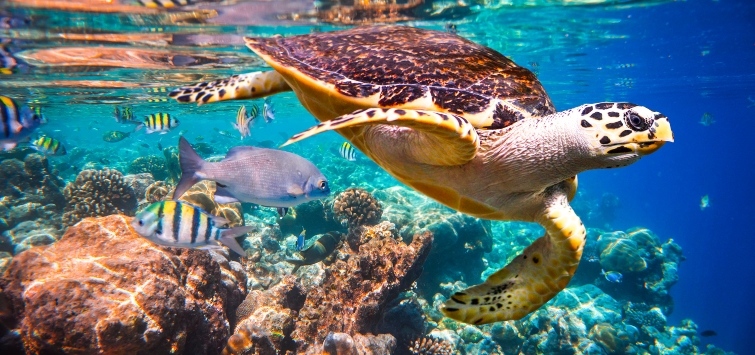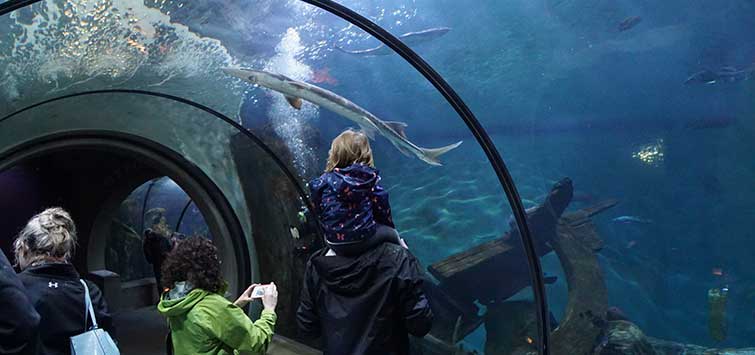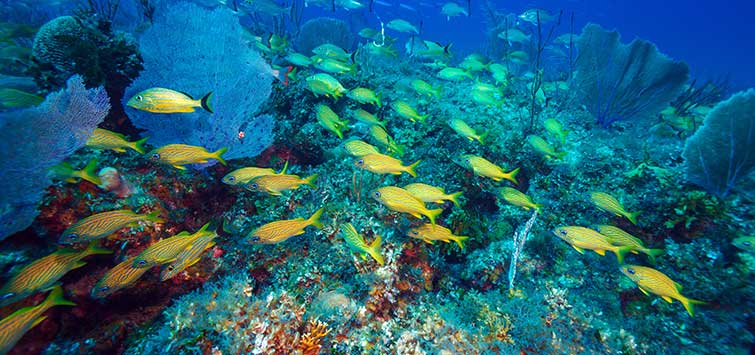Snorkeling in the Maldives
Author: John Robertson
An adventurous soul took a snorkeling trip to the Maldives, where he encountered everything from peaceful aquarium fish to sharks, rays, and aggressive triggerfish.
Travels in Vilamendhoo
To celebrate our 25th wedding anniversary, my wife and I set out on our holiday of a lifetime to the Maldives, a group of tiny islands west of Sri Lanka in the Indian Ocean. As we both love snorkeling, we did our research and selected Vilamendhoo, an island with easy access to the coral reef. (Many of the Maldives islands are surrounded by a large lagoon where a boat is needed to reach the reef).
From the capital, Male, we took a sea plane, which gave us great aerial views of Vilamendhoo and nearby islands, sand banks, and reefs.
Paradise x 1000
There are over 1,000 islands in the group. About 300 are inhabited, and over 50 are resorts with only one hotel to each island. Before our trip, we had hardly dared to hope that the hype advertising the Maldives is true, but beautiful Vilamendhoo lived up to all our expectations. The tranquility was wonderful, the food and service excellent, the equatorial climate superb, and the coral reef just fabulous. I simply cannot imagine a more perfect paradise on earth.
Snorkeling
I am not a scuba diver but snorkeling is the most peaceful pastime I have ever experienced, and I can’t think of another place in the world in which wild creatures come so near. In two weeks I spotted over 200 species of fish and, with my compact camera, was able to photograph well over 100 varieties. All this nature plays out in front of you, and many fish seem close enough to touch at times.
Butterflies and Parrots
Like coral reefs throughout the tropics, these sun-drenched surface waters are dominated by magical butterflyfish, surgeonfish that sweep to and fro, and large, striking parrotfish. Looking into the blue, thousands of iridescent green Chromis and hundreds of blue-toothed triggers, bannerfish, and pyramid butterflies forage plankton from the currents just off the reef.
There were over 20 species of butterflyfish to be spotted at Vilamendhoo, usually in pairs, daintily picking at corals, always busy. These included the stunning Meyers, orange-faced, and long-nosed butterflies, probing into the nooks and crannies of corals.
Also with a long snout is the poster fish of so many exotic locations, the amazing Moorish idol. As fantastic a fish as Salvador Dali might invent, these are everywhere you look, dashing about as if they are forever in a hurry.
Big and bold, there are numerous species of parrotfish, but it is not easy to identify them all. Like many reef fish, the young start as females and develop through color phases very different from the adults. A dominant individual turns male and rules a harem of mates. The larger species, such as the bicolor parrot and the sheepshead parrot, grow to well over 2 feet long.
Surgeons and Unicorns
There are many varieties of surgeonfishes and their relatives, the unicorn fishes. The unicorns tend to swim in open water, and this includes the splendid Vlaming’s unicorn, which changes color more swiftly than a chameleon. From uniform jet black, to brown with flashes of blue, to overall pale blue, each livery reflects a different mood and position in the local hierarchy. The pale blue seems to be saved for the attendance of the cleaner wrasses.
The surgeons and tangs were more closely associated with the shallow areas of the reef crest and back reef, where algal growth is best. The most numerous were the beautiful powder blue surgeons. Again these were literally everywhere I looked, but in some stretches of the reef they had a lot of competition from the dazzling striped surgeons, which are somewhat larger. The powder blues would often chase each other, but at times they would swim in groups to outnumber the striped surgeons.
Convict tangs took this strategy to a new level. Usually seen in small numbers in the lagoon between beach and reef, these would be pale to blend in with the sandy environment. Yet occasionally, they would gather in the hundreds to forage across the reef and overwhelm the larger species of surgeon that would otherwise chase them from the best food resources. At such times, the convicts moved like aquatic locusts over the rich areas of algae and their larger cousins could not defend their territories against them.
Clownfish Alley
Gorgeous clownfish, safe in their huge purple anemones, were also very common in the shallow waters. There was a part of the reef that generally had a powerful current and so many colonies of clownfish that we referred to this zone as “Clownfish Alley.” No doubt the current brings copious amounts of plankton for the fish and their hosts. Colorful crinoids with masses of feathery fronds also filtered these rapid currents.
Orange Clown
The lovely orange clown, endemic to the Maldives, was most numerous and lived in colonies of up to 20 fish, often with several anemones close together. Less common were the stunning black and white clowns, but these usually comprised just three or four fish hosted by one anemone.
Batfish Point
Another part of the reef we named “Batfish Point.” Every day, a pair of young batfish, still in their juvenile attenuated form, drifted about the ropes that held the floating marker that said “Danger, no snorkeling past this point because of strong currents.” Also at Batfish Point was always a group of small squid changing colors instantly, constantly, as they communicated with each other.
The corals in this part were the most splendid, with vast arrays of table coral and innumerable other forms nestled among them competing for the sun. The reef is home to many other invertebrates including brilliantly colored clams, ugly sea cucumbers as thick as my forearm, and starfish as big as dinner plates. An occasional lobster would poke its antennae out of its hideaway to discourage unwelcome fish.
Wildlife Mania
On the beaches, interesting wildlife can be found above the water line. Tiny hermit crabs scuffle across the sands seeking the shade of the palm trees. Handsome herons allow you to get almost close enough to touch as they fish in the shallows, their focus the epitome of concentration. Large fruit bats herald dawn and dusk with hooping cries, and yellow-headed lizards scamper away. Yet these fascinating creatures are nothing compared to the wealth of the reef.
Floating
As I floated slowly along the reef, other stunning fishes seen included tiny filefish, Valentini’s dwarf puffer, and the bold Hardwick’s wrasse.
Highly evolved predators such as the trumpetfish and cornet fish stealthily creep up and strike with electric speed at the small silvery fish that dash about the surface in the thousands. Looking rather like a giant, stiff pipefish, the trumpetfish comes in yellow and brown forms. Even more drawn out into slender tubes up to 2 meters (6 feet) long, gangs of cornet fish swam in parallel and inches away from us as we gently drifted along. Amazingly they were using us as cover, allowing them to sneak up on unsuspecting prey.
Sharks
To access the reef at Vilamendhoo there is only a narrow lagoon to traverse. The water here is usually full of sand particles, which creates an opaque environment of reduced visibility. Nonetheless, despite only occasional coral outcrops, the zone is full of life. Many young fish survive here. There are parrotfish that browse soft green algae in the shallowest of waters. Goatfish excavate the sand and raise clouds, and wrasses follow them to see what tasty morsels they disturb. Gobies in mating pairs retreat into well-constructed burrows when approached.
Numerous small stingrays lurk under the sand with only the spine-bearing tail projecting, easily mistaken for a twig. It is important to watch out before putting a foot or hand down when swimming.
Reef Sharks
These shallow sandy waters also contain numerous young blacktip reef sharks. Gleaming atherinids and herrings shelter here in huge numbers and the sharks glide gently into the bait balls, with dorsal fins ominously slicing the water surface. The sharks seem almost to be playing with the crowd of fish, but every now and then they put on a spurt and snap up a snack.
I lay motionless with my mask and snorkel, camera ready, in barely 2 feet of water until the glistening shoal accepted and enveloped me. I then patiently waited for the blacktips. Sure enough, wary at first, the predators circled around the edge and gradually made their way into the nervous shoal. In fact, so dense was the shoal that I barely got a second’s notice when a shark would glide through. The fish parted, panic stricken, dispersing in all directions, and I witnessed firsthand the perfection of evolution that sharks represent when hunting.
The Whitetip Reef Shark
Away from the lagoon larger blacktips of 3 or 4 feet in length are common over the reef, and three times I was treated to a 6-foot whitetip reef shark which glided past effortlessly just a few metres away. None of these sharks were in the slightest bit threatening to me, and by all accounts shark attacks are virtually unknown in the Maldives.
Dangerous Triggers
One fish on the reef was a real hazard, though. I have read often enough that titan triggers aggressively defend their nest when breeding, but my previous encounters have been infrequent and they were usually at some depth below me. At Vilamendhoo, however, there were numerous titans, seemingly spread out, each with their own territory, mostly in shallow water patrolling the back reef and ocean-facing crest.
Two snorkelers were attacked by these large triggers during our visit to Vilamendhoo. One lady received a nasty bite in the midriff, and the other a savagely bitten big toe. I understand that in both attacks the victims had been in a group of snorkelers, and I suspect they were swimming erratically and splashing about. This may have upset the temperamental fish.
I came upon these powerful fish several times each day and saw no sign of a nest nor aggression, but I was careful to swim very calmly and gently away whenever I found myself too close. Titan triggers are a formidable prospect and must be taken seriously by any swimmer or diver.
Other Fish
There are numerous other sizable fish on the reef that offer no threat to snorkelers in the least, such as beautiful groupers and stunning striped sweetlips. Usually by day these fish take refuge under overhangs and table corals in the company of soldierfish and squirrelfish, but once in a while they would be found basking in the sunlight.
Morays
Several times, morays, the largest of which was over 2 meters (6 feet) long, would slide calmly along the reef a few meters below. One day I caught a regal angel contesting territory rights with a moray, who I suspect just wanted to be left alone.
In deeper water wandered the incomparable blueface angel, conspicillum triggers, and a vast shoal of tightly packed kasmira snappers.
Highlights of Vilamendhoo
Excursions from Vilamendhoo offer the exciting possibilities of close encounters with mantas and whale sharks. Our trips were unsuccessful, but other vacationers were lucky enough to experience these giant fishes up close.
Thila
We did have one treat when we visited a nearby Thila (a small coral island that does not quite reach the surface). In 6 meters (20 feet) of clear water, I was able to leisurely observe and photograph a beautiful hawksbill turtle as it fed and explored. It came up to the surface very close to me on two occasions.
Volcanic Remains
The Maldives are of volcanic origin, and each group of islands forms a rough circle around giant, long-extinct craters called atolls. Over geological time, as the volcanoes have subsided slowly into the Indian Ocean, corals in the shallows have grown up toward the sun. Their skeletons, built up over eons, now form the structure of the reefs that surround the atolls.
Maldives Islands in a Nutshell
None of the Maldives islands are more than 2 meters (6 feet) high, being little more than sand banks with a flora of palm trees and mangroves. At barely 600 meters (2,000 feet) long, Vilamendhoo is average for the Maldives. These islands are therefore vulnerable to rising sea levels and erosion, and sadly it is predicted that many islands will disappear over the next few decades. It is not surprising then that the people and government of the Maldives are very aware of global warming and other environmental issues. Furthermore, the coral reef and tourism are so fundamental to their economy that they are very responsible about protecting their wildlife and marine ecosystems.
It would be a sorry legacy of modern man if these beautiful locations are not sustained.
The Napoleon Wrasse
Several times during our vacation, I enviously overheard divers talking about a beautiful Napoleon wrasse that lurked in the depths. One early morning I spotted him, just a tantalizing silhouette as he crossed the sandy stretches at the foot of the reef. Then on my last afternoon swim, I saw a large shadowy creature approaching across the back reef, obscured by the suspended sediment of the lagoon waters. As it moved slowly toward me, I had an ominous feeling that this bulky fish, about 4 feet long, may not be too friendly.
I need not have worried, though, as he glided serenely past me only a few feet away. When he reached the crest of the reef, he paused for just a second or two with the blue ocean as a backdrop, as if to bask in the afternoon sunshine and ask, “Am I not splendid?”
He seemed to sum up our whole Maldives experience.
See the full article on TFH Digital http://www.tfhdigital.com/tfh/201303#pg99

.png?h=595&iar=0&w=2781&hash=5FD5E69473BCC22199FBFA2FB71B6033)



